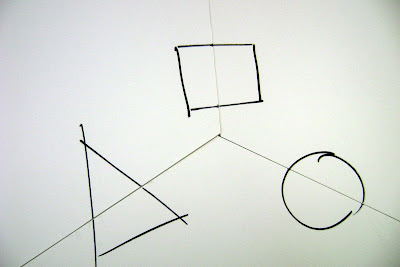 Observations: Here we begin to appreciate the overall 3 D effect. Very pleasing. It is interesting to note how much more enhanced the effect is when viewed from this side angle. I imagine this is due to the extra perspective provides the brain with additional information with which to reach a conclusion i.e., the smaller of the two vertical members must be a distant wall.
Observations: Here we begin to appreciate the overall 3 D effect. Very pleasing. It is interesting to note how much more enhanced the effect is when viewed from this side angle. I imagine this is due to the extra perspective provides the brain with additional information with which to reach a conclusion i.e., the smaller of the two vertical members must be a distant wall.Themes: I am pleased that the general intentions of the piece accurately portray the many themes and sub themes that are expressed here. With space, and a carbon atom you can build an entire omniverse full of ever-changing and developing organisms, one of which is capable of contemplating its own existence and expressing it with equal infinite variety.
Mounting: Given that tessellating per se in a continuous background has in effect been well covered, I am intend to explore options of mounting which include leaving spaces so as the create the effect of a large molecule, another reminder of infinite variety of level building.
Overlapping and mounting within another so as to create a 'box in a corner effect' will also be explored.
I can see that mounting at a pronounced angle will add an extra animation and heft element and as though it is midst tumble. This arrangement also creates great flexibility, and provides for replenishment as pieces are sold. This in fact only adds to the effect of its ever-changing continuous creation status, as well as different arrangements.

 Part solution: An off campus laser cutting company has offered to cut one sheet of wallboard for $45 - providing me with 5 cubes. Sufficient for now. I suspect I will have these 5 before I could
Part solution: An off campus laser cutting company has offered to cut one sheet of wallboard for $45 - providing me with 5 cubes. Sufficient for now. I suspect I will have these 5 before I could 

 Meantime: While waiting for what I will make 3 works using white foamboard to determine what is to be learned about making corrections. Also I can prepare how to lay out the room in prep for a large number of items being painted and dried with undercoat. A key will ensure correct assembly.
Meantime: While waiting for what I will make 3 works using white foamboard to determine what is to be learned about making corrections. Also I can prepare how to lay out the room in prep for a large number of items being painted and dried with undercoat. A key will ensure correct assembly. 
















 Justin Marshall
Justin Marshall  Andrea Bugli
Andrea Bugli



 After all the brain lightening, I need to get on with the practicalities of doing, which at this point involves working out a size for my tessellated isometric cubes bearing in mind the size of the raw material - custom wood. It is my intention to utilise off cuts from building sites and the like.
After all the brain lightening, I need to get on with the practicalities of doing, which at this point involves working out a size for my tessellated isometric cubes bearing in mind the size of the raw material - custom wood. It is my intention to utilise off cuts from building sites and the like. 



 I am pleased that this piece conveys well my original vision of continuously folding planes of geometry as well as overjoyed at the final effect. The various facets and unfinished creases provided and endless play of light and animation for the viewer that was unexpected. This aspect alone is worth further investigation in the future.
I am pleased that this piece conveys well my original vision of continuously folding planes of geometry as well as overjoyed at the final effect. The various facets and unfinished creases provided and endless play of light and animation for the viewer that was unexpected. This aspect alone is worth further investigation in the future. I will be pleased to see how this piece responds in different lighting conditions. I am immediately struck by its resemblance in essence to Picasso's Gurnica, and the work of Escher as well as Gaudi. An excellent suggestion by Karl (tutor) to do 2 more works at a much larger scale were thwarted by the limitations of the available PVC sheets. Should I locate a larger sheet size, I would continue this thread to exploit the warping properties of the PVC. There are endless possibilities to record due to the warping and reflective nature of the surfaced. I am very tempted to take to piece into different sites to record what happens in the reflection.
I will be pleased to see how this piece responds in different lighting conditions. I am immediately struck by its resemblance in essence to Picasso's Gurnica, and the work of Escher as well as Gaudi. An excellent suggestion by Karl (tutor) to do 2 more works at a much larger scale were thwarted by the limitations of the available PVC sheets. Should I locate a larger sheet size, I would continue this thread to exploit the warping properties of the PVC. There are endless possibilities to record due to the warping and reflective nature of the surfaced. I am very tempted to take to piece into different sites to record what happens in the reflection.
 For more details of this work go to:
For more details of this work go to:










